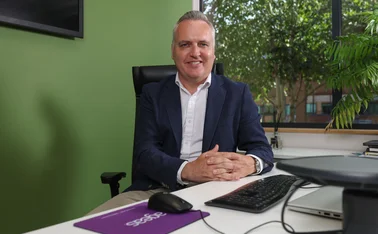
Analysis: Are AI solutions being used to mitigate risks?

Need to know
- 87% of insurers are investing more than $5m (£3.8m) a year into AI
- AI enables insurers to pull in around 250 different rating factors
- AI can also be used to enable insurers to see if their customers’ risk is changing dramatically from renewal to renewal
In the commercial space, artificial intelligence has the potential to enable an insurer to get all the information it needs to write a risk in a matter of hours and support customers’ risk management activity, but only if it is deployed appropriately
Artificial intelligence could transform the insurance market, reducing risk and giving underwriters and claims professionals a deeper insight into their customers. But, while the potential is huge, insurers must manage adoption of this technology carefully.
The potential is recognised by Ted Stuckey, managing director of QBE Ventures. “We’re right at the beginning of the journey but, over time, insurers will become AI driven organisations,” he says. “It’s very exciting.”
Already there are signs of some serious commitment to this technology. Research by Genpact, a global professional services firm that focuses on digital transformation, shows that 87% of insurers are investing more than $5m (£3.8m) a year into AI. In addition, more than half of them are planning to use the technology to transform their business processes in the next three years. “We’re seeing more activity in the personal lines space, with both underwriting and claims processes benefiting from its application,” says Sasha Sanyal, global business leader, insurance, diversity and corporate social responsibility at Genpact.
It’s not surprising either. Thanks to the large amount of data it uses and the processes in place across the insurance industry, it’s a natural habitat for AI.
The market is ready for transformation too. “Today’s insurance market isn’t meeting the needs of millennials and generation Z,” says Abhinav Somani, CEO at Leverton, a provider of AI-powered technology for data extraction and contract analytics. “Traditional insurance instruments were built more than 75 years ago for the baby boomer generation. The younger generations want smarter products that are easier to consume.”
Understanding risk
Building these smarter products starts at the underwriting stage, with AI enabling underwriters to gain much more insight into a risk. David Williams, managing director, underwriting and technical services at Axa Insurance, says that while underwriters were once happy to price on the back of an address and the sum insured, today, AI enables them to pull in around 250 different rating factors. “It’s not just about using these additional factors in a straight, linear way,” he adds. “Machine learning explores the way they interact to give a more accurate rating.”
Using AI to crunch through the data can identify patterns that may never have been visible to the human eye. As an example, Stuckey points to a link identified by Cytora, one of its AI partners. “It found there was a correlation between the distance from the parking space to the front door, the average ground temperature and the number of trips and slips,” he says. “Without AI, how would anyone ever come up with this conclusion?”
Having this insight also means that insurers can develop richer risk appetites according to Dave Ovenden, global director, pricing, product, claims and underwriting at Willis Towers Watson. “An underwriter can look at a risk from so many more angles to help them make a better decision,” he says. “This might mean they decide to survey different risks or insure others they would have previously declined. It gives them much more insight.”
Unsurprisingly, there are plenty of insurtech start-ups looking to provide tools and support the insurance industry. Among those on the insurers’ radars are Geollect, which uses machine learning algorithms to provide new insights from data feeds, and Cyence, which is used to quantify cyber risk exposures.
Driving operational efficiencies
As well as gaining more insight into customer risk, AI can squeeze more operational inefficiency out of an insurance business. “AI lets an insurer automate some of the more mundane tasks, freeing up employees to focus on more complex cases,” Stuckey explains. “This removes the risk of human error.”
To illustrate this, he points to the improvements QBE has seen in Australia by working with automation specialists Hyperscience. By using image recognition, it can extract relevant data from medical certificates handwritten by doctors. “As the handwriting could be difficult to read or outside of the boxes, this used to be a manual task but, thanks to advances in AI, it’s all automated now,” he explains. “It’s a massive opportunity for us.”
AI can also be used to enable insurers to see if their customers’ risk is changing dramatically from renewal to renewal. Somani says that rather than use data to generate a risk profile at inception, AI will constantly pull data from social media posts, credit card purchases and other areas to keep it up-to-date.
This insight can be valuable. As an example, he says that a loan company in the US might receive an alert if a minimum wage worker earning $10 an hour posted online that they’d just bought a new BMW. The company could then contact the customer to check they were still able to meet their payments.
Similarly, rather than looking at an individual policyholder, an insurer can use AI to help it track and respond to changing consumer trends. To illustrate this, Somani points to how Uber is changing the shape of the motor insurance market in the US. “Personal motor insurance has gone down as people no longer need to own a car but private driver insurance has drastically increased due to the growth of Uber,” he explains. “AI systems allow insurers to change their business model quickly and efficiently as these trends morph every few years.”
Improving the customer journey
Customers are also seeing improvements in their interactions with insurers as a result of AI. While there’s been an explosion in the amount of data being used to underwrite, AI is also being used to reduce the amount of information the customer needs to provide.
Already this is happening with postcodes for addresses and driving licence numbers for conviction details, but AI allows insurers to go further. “Rather than answer lots of questions, a motorist should be able to take out car insurance by providing three photos: one of the car’s registration number, a second of their driving licence and a selfie,” says Gurpreet Johal, partner and head of the AI team at Deloitte.
Improvements in the customer journey aren’t limited to less time completing application forms either. Leverton recently worked with Simplesurance to enable it to roll out its insurance comparison service across the European Union. By using AI to automate the sourcing, structuring and benchmarking of data from insurance policies, Simplesurance was able to cut its data processing time by 75% to ensure a good customer experience.
In the commercial space, this type of exercise has the potential to save even more time for customers. “AI will enable an insurer to get all the information it needs to write a risk in a matter of hours,” says Johal. “For a commercial property this might have involved sending a surveyor, which could easily mean this process takes six to eight weeks.”
Information exchange
As well as helping to improve underwriting, the risk insight generated through AI can also be shared with customers. Alan O’Loughlin, head of analytics and statistical modelling at Lexis Nexis Risk Solutions, explains: “If a corporate client is considering a relocation, an insurer could provide information, such as the potential increase or decrease in footfall or the crime rate in the area, that might influence their decision.”
This insight can also be used to support customers’ risk management activity. For instance, by using AI an insurer might identify that the risk of a shop being broken into increases in autumn, especially when it’s half-term and the weather’s fine. This information can then be pushed out to customers so they can take appropriate steps to improve their security.
Even more long-term insight can be shared according to Stuckey. “Jupiter uses AI to model climate change, drilling drill right down to the individual building level,” he explains. “This information can be shared with customers to enable them to protect themselves from future weather events.”
With AI, giving back to the customer isn’t limited to risk insight either. By analysing the data, it’s possible to create differentiated and more personalised customer propositions. Martin Micko, founder and chief operating officer at Omnius, explains: “If an insurer sees that a lot of people in a particular demographic are having a certain type of motor accident, it could create a new product to meet their needs. This insight can transform insurers into customer-focused, data-driven businesses.”
As well as using AI to create variations on today’s insurance cover, it’s also likely to drive more fundamental change with insurers offering a range of services to their customers, with insurance much more of a secondary product. “It will become part of a broader service, with insurers using AI to help their customers understand and manage risk better,” says Johal. “It could be highlighting the performance of drivers to a fleet manager or alerting home owners to bad weather or trends in theft that might affect them.”
Claims controls
AI is also transforming the claims process, with Micko saying this is where most attention is currently focused. “When we looked into the claims management process, we saw that insurers were adding a couple of data points at each step. It was a cumbersome and expensive process, with huge potential for error,” he explains. “An AI-driven solution can extract 50 to 100 data points from all the supporting documentation at the first stage, saving time and money.”
Further support comes through triaging claims, with AI able to assess photographs of vehicle damage to determine whether it’s a repair or a write-off. And, in fraud detection, Pete Allchorne, partner at DAC Beachcroft, says AI can really help identify fraud issues. “Lemonade has a chatbot that runs through 18 anti-fraud algorithms and Hanzo uses a web-crawling AI powered solution to automate social media investigations,” he adds.
Honest customers can also benefit. Ovenden says that where AI identifies a policyholder with a high degree of trust, tolerances can be adjusted. “This insight might enable an insurer to settle higher value claims automatically with these customers,” he adds. “It cuts down risk for the insurer and delivers an enhanced service to the right customers.”
While AI has the potential to transform the insurance industry, insurers also need to be mindful of the risks. The first major risk comes with the data itself, as Somani explains: “If the data sets are not organised and structured, AI will have a tough time mining it or will come up with biased answers.”
The importance of reliable data can be an issue for insurers, with Ovenden admitting that data husbandry hasn’t always been the best. “Many systems were built in the 1980s when data storage was expensive so it wasn’t always retained,” he says. “Data quality isn’t always as rich as it should be either. Stating a claim is escape of water doesn’t give you the granularity you’d get if you explained the cause.”
Transparency
Data cleaning and enrichment processes can address these issues but it’s also important that there’s plenty of transparency around what is being used. Williams explains: “AI might be favouring customers with pink cars or with particular occupations that could be a proxy for gender. You need to understand exactly what AI is doing.”
Without this understanding, an insurer can find itself in trouble with the regulator and, if personal data is used without consent, the Information Commissioner’s Office too. O’Loughlin says that strong governance is a must. “If you can’t explain why a piece of data is predictive of risk, then you can’t use it,” he says.
An insurer’s relationship with its customers can also be at stake if AI is not deployed appropriately. There can be a lot of apprehension around new technologies and data use, especially where they might see their usual 20-page application form shrunk down to three questions and a photograph.
A measured roll-out and familiarity can help. For instance, Ovenden points to image recognition. “Customers have already seen it in medical screening so are comfortable with it,” he explains. “Confidence can also grow when they get a benefit in return, for instance an improved product or lower price. Insurers do have to build trust.”
But taking a softly-softly approach can be dangerous. With disruptors such as Lemonade and Metromile transforming the insurance proposition, more traditional insurers must make sure they don’t get left behind. Striking the balance between embracing this technology and minimising customer alarm is essential.
Only users who have a paid subscription or are part of a corporate subscription are able to print or copy content.
To access these options, along with all other subscription benefits, please contact info@postonline.co.uk or view our subscription options here: http://subscriptions.postonline.co.uk/subscribe
You are currently unable to print this content. Please contact info@postonline.co.uk to find out more.
You are currently unable to copy this content. Please contact info@postonline.co.uk to find out more.
Copyright Infopro Digital Limited. All rights reserved.
As outlined in our terms and conditions, https://www.infopro-digital.com/terms-and-conditions/subscriptions/ (point 2.4), printing is limited to a single copy.
If you would like to purchase additional rights please email info@postonline.co.uk
Copyright Infopro Digital Limited. All rights reserved.
You may share this content using our article tools. As outlined in our terms and conditions, https://www.infopro-digital.com/terms-and-conditions/subscriptions/ (clause 2.4), an Authorised User may only make one copy of the materials for their own personal use. You must also comply with the restrictions in clause 2.5.
If you would like to purchase additional rights please email info@postonline.co.uk








